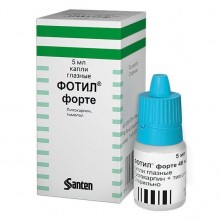



Combined antiglaucoma drug.
Pilocarpine - m-cholinomimetic. When instilled into the eye, pilocarpine causes miosis, accommodation spasm and reduces intraocular pressure. The reduction in intraocular pressure is due to the contraction of the ciliary muscle and the muscles of the iris, which leads to an increase in the angle of the anterior chamber of the eye and changes the physical structure of the trabecular meshwork, facilitating the outflow of aqueous humor. This effect lasts from 4 hours to 14 hours.
Timolol, as a beta-blocker, prevents the binding of sympathomimetic neurotransmitters with β1- and β2-adrenoreceptors in the ciliary body. Reduces intraocular pressure, reducing the production of aqueous humor. The hypotensive effect occurs 20 minutes after instillation, reaches a maximum after 2 hours and lasts about 24 hours.
Glaucoma or increased intraocular pressure when a combination of timolol and pilocarpine is needed:
1 ml of eye drops contains:
Active ingredients: timolol maleate 6.84 mg, pilocarpine hydrochloride 40 mg.
Excipients: benzalkonium chloride - 0.1 mg, citric acid - 0.88 mg, sodium citrate - 6.13 mg, hypromellose - 5 mg, water d / and - up to 1 ml.
Fotil® is marketed under different brands and generic names, and comes in different dosage forms:
| Brand name | Manufacturer | Country | Dosage form |
|---|---|---|---|
| Fotil forte | Santen | France | eye drops |
| Fotil® | Santen | France | eye drops |
No customer reviews for the moment.
Treatment should begin at the first manifestations of the disease to prevent the sharp development of its exacerbation.
1% cream Elidel 2 times a day, apply a thin layer on the affected surface and gently rub until completely absorbed.
Elidel 1% cream can be applied to the skin of any parts of the body, including the head, face, neck, as well as diaper areas.
Cream Elidel should be applied 2 times a day, until the complete disappearance of symptoms of the disease. If the severity of symptoms persists after 6 weeks of use of the drug, it is necessary to re-examine the patient to confirm the diagnosis of atopic dermatitis. After cessation of treatment, in order to avoid subsequent exacerbations, therapy should be resumed at the first sign of atopic dermatitis recurrence.
Emollients can be applied immediately after applying 1% Elidel cream. However, after water treatments, emollients should be applied before applying Elidel cream.
Given the very slight systemic absorption of pimecrolimus, there are no limitations to the total daily dose of the applied preparation, the area of the treated skin surface or the duration of treatment.
If Elidel gets into eyes, mucous membranes (oral or nasal cavities), immediately remove the cream and rinse eyes and mucous membranes with running water.
Applying 1% Elidel Cream can cause minor transient reactions at the site of application, such as a feeling of warmth and / or burning. At considerable severity of these reactions, patients should consult a doctor.
The most common adverse events were reactions at the site of application of the drug in 19% of patients treated with 1% Elidel cream and in 16% of patients from the control group. These reactions mainly occurred at an early stage of treatment, were minor / moderate and short. The following adverse events are listed in frequency, starting with the most frequent. The frequency of occurrence of undesirable reactions was estimated as follows: arising “very often” - ≥1 / 10, “often” - ≥1 / 100 <1/10, “sometimes” - ≥1 / 1000 <1/100, “rarely” - ≥ 1/10 000 <1/1000, “very rarely” - <1/10 000, including individual messages.
The undesirable reactions presented below were noted in the post-marketing use of the drug (an estimate of the frequency by the number of cases of AE in an unspecified population).
Carefully
Potential interactions of 1% Elidel cream with other drugs have not been studied. Given that the systemic absorption of pimecrolimus is very small, any interaction of Elidel cream with drugs for systemic use is unlikely.
When applying Elidel cream in children aged 2 years and older, the drug did not affect the effectiveness of vaccination.
It is not recommended to apply the cream on the vaccine injection area until the local manifestations of the post-vaccination reaction completely disappear.
Incompatibility. Since compatibility studies have not been conducted, it is not recommended to use the drug in conjunction with other local means.
In the treatment with topical calcineurin inhibitors, including Elidel, in rare cases, malignant neoplasms have been observed (for example, skin tumors and lymphomas). The causal relationship between these adverse events and the use of the drug has not been established.
In clinical studies with the use of Elidel cream, 0.9% of patients (14 out of 1544) developed lymphadenopathy. Typically, lymphadenopathy was due to infectious diseases and disappeared after a course of appropriate antibiotic therapy. In all patients, either it was possible to identify the cause of the development of lymphadenopathy or the disappearance of this adverse event was noted. In patients receiving treatment by Elidel with the development of lymphadenopathy, it is necessary to establish the etiology of the process and ensure that patients are monitored until this undesirable phenomenon completely disappears. If the etiology of lymphadenopathy is unknown or the patient has acute mononucleosis, the drug should be discontinued.
When treating with Elidel cream, patients are advised to minimize artificial or natural skin insolation or to completely avoid ultraviolet radiation.The possible effect of the use of the drug in skin lesions caused by ultraviolet irradiation is unknown.
Influence on ability to drive motor transport or work with mechanisms:
The impact of the use of Elidel cream on the ability to drive vehicles or work with mechanisms has not been established.
Cases of overdose or accidental use of 1% Elidel cream orally were not observed.